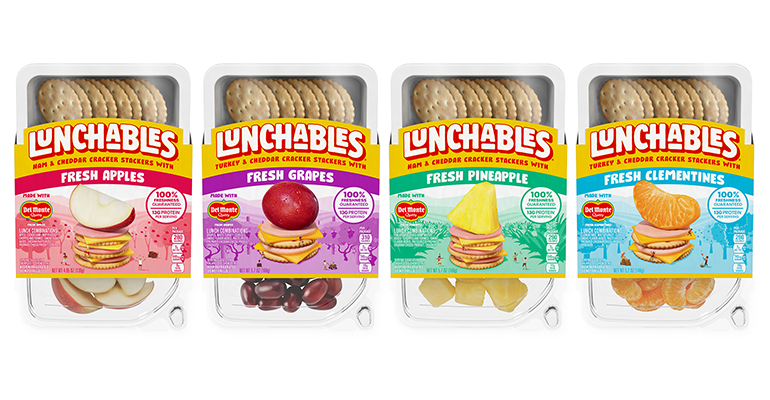Welcome to SJGLE.com! |Register for free|log in
Welcome to SJGLE.com! |Register for free|log in

Related Searches: Tea Vitamin Nutrients Ingredients paper cup packing
The packaged food manufacturer, which is jointly headquartered in Chicago and Pittsburgh, said the Lunchables with Fresh Fruit range was the latest example of its desire to offer more better-for-you options.
Inspiration for the launch came after seeing a 500% increase in social media searches for “Lunchables with fruits and vegetables” in the past year, it said.

Lunchables debuts four new fresh fruit offerings in partnership with Fresh Del Monte. (Photo: Business Wire)
Lunchables products are made up of wheat crackers with slices of meat, such as turkey and ham, or cheese that can be stacked; the brand markets these as “cracker stackers”. The Del Monte partnership means the plastic-packaged boxes in this range will also contain slices of fresh apples, grapes, pineapple, or clementine slices. Lunchables were already available with branded confectionery products, such as Kit Kats and Airheads, or chocolate cookies.
The fruit launch was timed to coincide with the back-to-school season at the start of September in the US.
Naor Danieli, director of marketing for Lunchables at Kraft Heinz, said: “Lunchables with Fresh Fruit is a ripe example of how we are quickly moving to introduce new offerings rooted in real consumer needs. Teaming up with Fresh Del Monte helps accelerate the innovation our brand strives for, lending its expertise in fresh produce to expand the delicious, buildable and real food experience we provide for kids.”
Melissa Mackay, vice president of marketing at Fresh Del Monte, said the fresh produce supplier saw the partnership to introduce Lunchables as “a true game changer for children’s nutrition”.
“[...] we have a real opportunity to change kids’ perspectives around fruits, ideally helping to make fruit consumption second nature to younger generations. It aligns closely with our mission to inspire healthy lifestyles and provide wholesome and convenient products to everyone,” she said.
Kraft Heinz has been pursuing a strategy to expand sales of Lunchables by targeting schools. Earlier this year, two Lunchables products that met the nutrition guidelines of the US National School Lunch Program became available in US schools while Kraft Heinz CEO Miguel Patricio called the strategy of expanding its distribution via the US school system as “a penetration machine”.
These comments, cited in the Wall Street Journal, drew criticism from food policy and public health writer Tamar Haspel who said on social media it was part of a wider strategy to simultaneously drive demand for unhealthy products in Kraft Heinz’s portfolio.
“This is how crap food becomes ubiquitous. Starts with Kraft Heinz making Lunchables to meet school nutrition guidelines in order to hook kids,” she tweeted.
Kraft Heinz said it has a continued focus on reducing sodium, sugar, and saturated fat within its products, and that it had recently reduced the salt and oil ingredients in its Lunchables crackers.
Earlier this year, non-profit organisation World Action on Salt, Sugar and Health (WASSH) and responsible investment non-profit ShareAction assessed more than 2,000 products made by five of the biggest global food and drink companies – Danone, Kellogg’s, Kraft Heinz, Nestlé, and Unilever –using national definitions of what constitutes healthier food and drink in Australia, France, and Mexico.
It found that Kraft Heinz’s food range was the least healthy in Mexico and France, with 100% of its 11 products sold in Mexico and 51 products (93%) in France classified as unhealthy.
E-newsletter
Tags